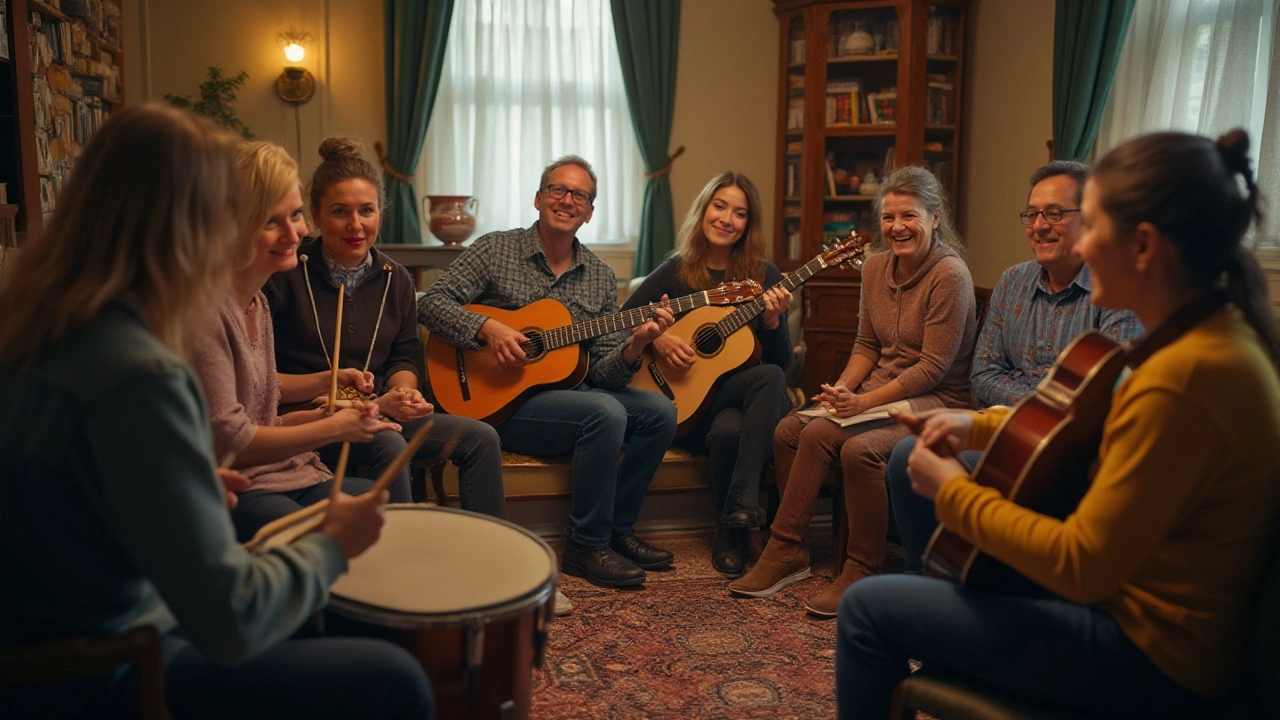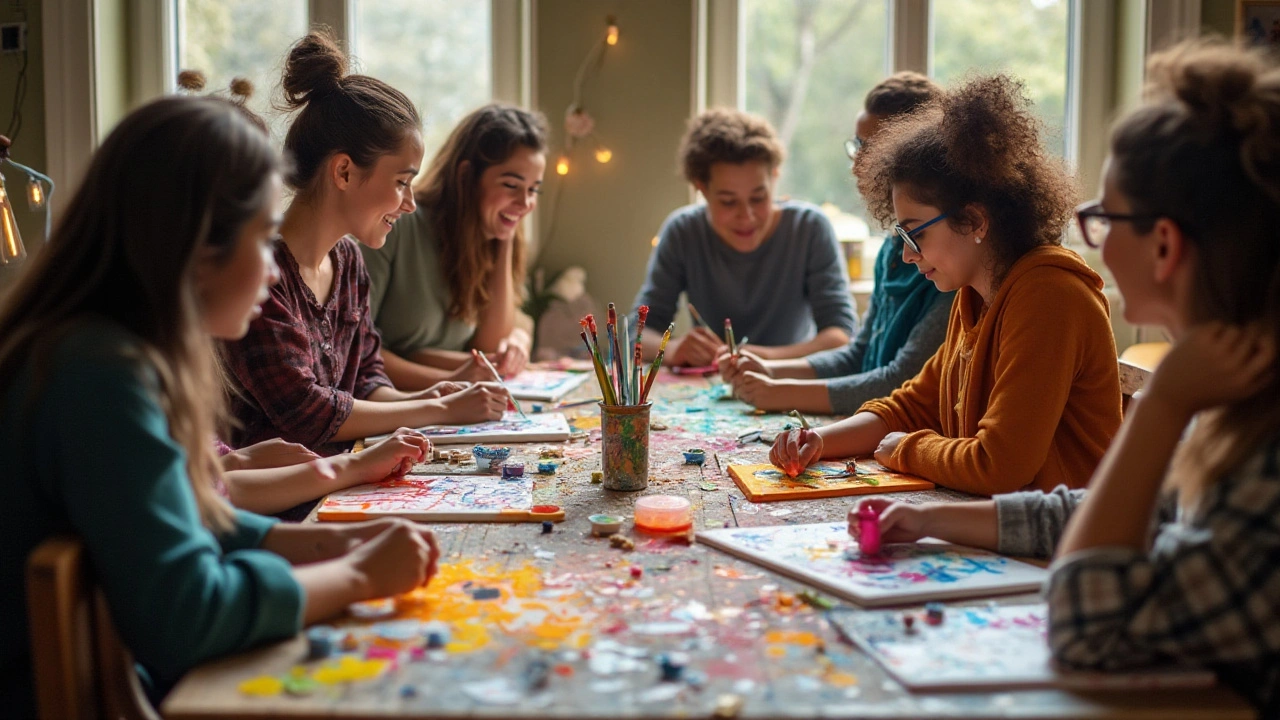In the realm of self-discovery and emotional growth, creative arts therapies have emerged as a beacon of innovation and warmth. Engaging in activities like painting, sculpture, music, and dance not only allows for a personal escape but also helps in deepening the understanding of one's emotions.
By tapping into the creative side, individuals find new ways to express feelings, leading to improved emotional clarity and resilience. This article sheds light on how these therapies can be both a delightful journey and a profound tool for enhancing emotional intelligence, contributing to overall well-being and personal growth.
- Introduction to Creative Arts Therapies
- Connecting Creativity with Emotion
- Benefits of Enhanced Emotional Intelligence
- Artistic Expression as a Therapeutic Tool
- Tips on Incorporating Arts into Daily Life
- Success Stories and Real-life Applications
Introduction to Creative Arts Therapies
Creative arts therapies have become a fascinating and effective approach to emotional healing in recent years. These therapies use diverse art forms like music, dance, drama, and visual arts to promote psychological well-being. By engaging the mind and body in creative processes, individuals are provided with tools to express thoughts and emotions that might otherwise remain silent and hidden. It is a therapeutic journey where words aren't always necessary; instead, the power of color, rhythm, and movement speaks volumes. The inclusion of these diverse methods can be especially beneficial for those who find conventional therapy challenging.
The origins of creative arts therapies trace back to the 1940s and 50s when professionals noticed the significant impact of art, dance, and music in therapeutic settings. The realization that these mediums could facilitate emotional resolution and expression led to their incorporation into mental health practices. Today, they are recognized globally, not just for rehabilitation but for enhancing emotional intelligence—a crucial factor in managing personal and professional relationships. Studies have found that engaging in arts-based activities can significantly reduce symptoms of anxiety and depression, helping individuals lead more balanced lives.
"Art is a wound turned into light," once said French painter Georges Braque. This quote perfectly encapsulates how art can transform pain into understanding and growth.
Each type of creative art therapy has its unique processes and benefits. Art therapy might involve creating paintings or sculptures which aid people in visualizing and processing their emotions. Music therapy uses rhythm and melody to help clients communicate their feelings. Dance therapy encourages body movements that release emotional blockages and foster a free expression. Drama therapy lets participants act out scenes that can mirror real-life situations, providing insights and emotional release. Each approach is tailored, recognizing that creativity knows no bounds, and its journey is as unique as each person involved.
Research indicates that beyond emotional healing, creative arts therapies contribute to brain development and plasticity. When individuals engage in painting or playing an instrument, for instance, the brain's neural connections increase, leading to enhanced cognitive function. This direct involvement in creation also boosts self-esteem, making people feel more competent and confident. With today's fast-paced lifestyles, creative arts therapies provide a genuine pause, offering a moment to tune into one's emotions and thoughts—an essential aspect in nurturing emotional intelligence.
Connecting Creativity with Emotion
Imagine a world where colors spoke louder than words and music expressed feelings that were too complex to articulate. This is the essence of creative arts therapies, where creativity becomes a bridge between an individual’s inner world and their emotional expression. The notion that engaging with creative arts therapies can significantly enhance emotional intelligence revolves around the ability of art to reach places in the psyche that words cannot. When an individual engages in painting, for instance, they're not just mixing colors but also exploring the spectrum of their emotions. The very act of choosing a color can symbolize choosing how to express a feeling, and this decision-making process fosters deeper emotional awareness.
In music therapy, the rhythm of a drum or the melody of a piano can mirror one's heartbeat or emotional state, creating an intimate dialog between the inner self and the external world. Research illustrates that engaging with music can reduce anxiety and improve mood by regulating brain pathways associated with emotion. According to a study by the American Music Therapy Association, patients who participated in music therapy showed improvements in emotional expression and processing. This supports the idea that creativity isn't just an outlet but a vital tool in understanding and refining our emotional intelligence.
Delving into dance or drama therapy allows participants to physically channel emotions that are otherwise trapped. Movement helps in releasing stress and pent-up feelings, connecting the mind and body in a harmonious dance of awareness. When we talk about emotional intelligence, it often involves understanding our emotions and those of others. Dancing or acting provides a way to experience empathy by literally stepping into someone else's shoes. Such activities cultivate an understanding that stretches beyond verbal comprehension, encapsulating an experiential learning that is both engaging and enlightening.
“Art washes away from the soul the dust of everyday life.” — Pablo Picasso
The journey doesn't end at individual experiences. When shared in a group setting, creative arts therapies can foster a sense of community and shared understanding. It becomes a safe space for individuals to exchange insights and learn from one another's expressions. Participants often discover that their feelings aren't isolated, creating bonds and a support system that nurtures emotional growth. The result is a richer emotional vocabulary and improved capacity to navigate interpersonal relationships.
Collectively, these forms of therapy underscore the powerful link between creativity and emotion, showing that the arts are not merely a pastime but a pathway to greater self-awareness and emotional depth. Thus, integrating creative arts into one's routine offers not just an artistic outlet, but also a profound journey towards enhanced emotional intelligence.

Benefits of Enhanced Emotional Intelligence
Emotional intelligence plays a crucial role in shaping how individuals interact with the world and with themselves. When someone possesses a higher degree of emotional intelligence, they tend to navigate their personal and professional lives with greater ease. At its core, emotional intelligence is about understanding one’s own emotions and being able to relate to the emotions of others. This skill comes naturally to some, but it can also be cultivated through practices like creative arts therapies.
One of the key benefits of having enhanced emotional intelligence is the improvement in relationships. Whether it’s at home, in the workplace, or among friends, being attuned to emotions helps foster deeper connections. When individuals can interpret the subtlest of emotional cues, they become more empathetic and compassionate, which in turn leads to healthier, more fulfilling relationships. This is not just intuitive; a study in 2020 found a strong correlation between high emotional intelligence and relationship satisfaction.
Another advantage is that individuals with heightened emotional intelligence often experience reduced levels of stress and anxiety. The reason is quite simple – these individuals are better equipped to identify and manage their emotions before they escalate into stress-inducing situations. A person with strong emotional intelligence is adept at processing negative emotions and responding to them in constructive ways, rather than getting overwhelmed. This ability stems from the habit of using artistic expression as a medium to reflect and soothe one’s emotional state.
"Emotional intelligence is the ability to harness emotions and apply them as tools to solve everyday problems," says Daniel Goleman, a respected psychologist and author on the subject.
The impact on decision-making cannot be understated either. When emotion is in the driver’s seat, decisions are often made out of impulse rather than reflection. However, with improved emotional intelligence, individuals are more likely to engage their emotions as allies in the decision-making process. By addressing the emotional aspects of their choices, they consider long-term implications better, which can lead to more successful outcomes both personally and professionally.
Let's not overlook the importance of self-awareness, another hallmark of emotional intelligence. When people are acutely aware of their own emotions, triggers, and typical reactions, they can steer themselves toward positive change. This self-awareness enhances their ability to learn from mistakes and adapt to new situations, offering a foundation for personal growth and resilience.
For organizations, investing in boosting employees' emotional intelligence through initiatives such as creative arts activities can result in a more collaborative and innovative workforce. Many companies report marked improvements in teamwork and overall productivity when emotional intelligence is a focus of professional development. The spillover effect of this awareness and adaptability notably aligns with improved employee retention rates, as individuals feel more supported and understood.
Artistic Expression as a Therapeutic Tool
Diving into the vibrant world of artistic expression can be a remarkable avenue for therapy. Through the process of creating, individuals are able to release their emotions in ways that words may not fully capture. This form of expression taps into the subconscious, allowing hidden feelings and thoughts to surface in a non-threatening way. By engaging in art forms such as painting, drawing, or sculpting, people can confront emotions that are difficult to articulate verbally. Art thus becomes a silent yet powerful voice, conveying messages from the depths of our being.
Research has consistently demonstrated the positive impact of creative arts therapies on mental health. A report from the American Art Therapy Association highlights how art can reduce depression and anxiety symptoms, enhance problem-solving skills, and boost confidence. When individuals see their emotions transformed into tangible forms, it provides a visual release as well as validation of their internal experiences. The act of creation can foster a meditative state, reducing stress and promoting relaxation. Many find solace in the rhythm of brushstrokes, the tactile sensation of clay, or the harmony of colors.
What's truly fascinating is the way art forms can mirror and influence emotional states. Take colors, for instance. Warm tones like reds and oranges may evoke energy and passion, while cooler shades like blues and greens can instill a sense of calm and tranquility. This interplay of color and mood is a foundational aspect of art therapy, helping individuals not only express but also regulate their emotions. As individuals create, they often gain insights into their emotional triggers and patterns, developing a deeper understanding of themselves and others. It is as much a journey of self-discovery as it is a therapeutic intervention.
"Art enables us to find ourselves and lose ourselves at the same time." - Thomas Merton
Artistic therapy isn't just about creating masterpieces. Sometimes the mere act of holding a pencil or shaping clay can be liberating. The process overcomes perfectionism and fear of judgment, encouraging people to explore, experiment, and learn. By engaging in these activities, they often enter a flow state, characterized by a deep focus and a sense of well-being. This state can be incredibly therapeutic, offering respite from intrusive thoughts and worries. It's where time seems to suspend, and one is truly present in the moment.
With the integration of art into therapeutic settings, therapists can employ specific techniques to guide individuals through their healing process. Methods might include the use of metaphors and symbols in their creations or exploring the narratives behind their artwork. Such approaches can unearth emotions connected to past experiences, leading to breakthroughs and new perspectives. Importantly, it provides a space for storytelling, allowing individuals to reframe and reconstruct their personal journeys, often leading to emotional release and healing.

Tips on Incorporating Arts into Daily Life
Making art a part of everyday life doesn't have to be a daunting task; instead, it can be a joyful and fulfilling experience that seamlessly blends with your daily routine. By nurturing your creative side, you enhance not only your artistic skills but also your emotional health. Think about starting with something simple, like keeping a small sketchbook at hand. Doodle whenever you have a few spare moments, like those morning coffee sips. This small act of creativity helps shift your focus and calm your mind, which in turn fosters emotional intelligence.
Music, an accessible form of creative arts therapies, can play a significant role in your daily schedule. Create playlists that reflect your moods or goals for the day. Pay attention to how certain songs make you feel, and let those melodies guide your emotions positively. Share music experiences with friends or family, creating connections through shared emotional journeys. Sometimes, putting together a personal playlist can be as therapeutic as therapy itself, letting you explore a myriad of emotions safely and creatively.
The act of writing is another powerful tool - maintaining a journal not only records the day’s events but allows for introspection. Write about feelings, thoughts, and experiences without judgment. Journals are private spaces for free-flowing creativity that can significantly improve self-awareness and management of emotions. Occasionally, read back through your entries to notice patterns or progress. This reflective practice not only enhances your understanding of self but also improves emotional responses to life’s challenges.
Consider integrating more structured art sessions into your week. Join community art classes or gather a group of friends for a painting night. Such gatherings not only offer a creative outlet but also foster social connections, enhancing both community and personal growth. During these sessions, focus on expressing rather than achieving perfection. The process itself is what nurtures mental health and emotional development, not the final product.
In your workspace or living environment, make an effort to surround yourself with art that speaks to you. Create a small gallery of pieces that inspire positivity and introspection. Change them as your moods or the seasons evolve. Visual art-rich environments can quietly influence daily emotions and perspectives, serving as subtle reminders of the beauty and diversity of emotional life.
"Art enables us to find ourselves and lose ourselves at the same time," as Thomas Merton observed. This idea challenges us to integrate art into our lives creatively and consciously, finding new layers of emotion and expression.Daily doses of creativity don't need to be grand gestures. Embrace art in subtle ways, like choosing a creative route for an everyday task. Enjoy cooking as an art form; consider each meal a blank canvas waiting for your unique touch. Engage your senses fully in the process, translating emotions into culinary delights that nourish both body and soul. In these ways, gradually folding arts into everyday life catalyzes profound emotional growth and well-being.
Success Stories and Real-life Applications
Embarking on a journey with creative arts therapies can often lead to surprising and transformative outcomes. Take, for instance, the compelling story of Jessica, an elementary school teacher who turned to art therapy to cope with the overwhelming stress of her job. By engaging in regular painting sessions, not only did she find a reprieve from her daily pressures, but she also discovered an enhanced ability to empathize and connect with her students on a deeper level. This process refined her emotional intelligence, allowing her to manage her classroom more effectively and nurture a supportive learning environment. Jessica’s story exemplifies how creative engagement can lead to personal and professional growth simultaneously.
A similar narrative is found in the experience of Daniel, a corporate executive who struggled with workplace communication. He was introduced to drama therapy through a company wellness program. Although he was initially skeptical, Daniel soon found that role-playing exercises in a safe, creative space helped him recognize and interpret social signals more accurately. Daniel's capacity to navigate complex emotional landscapes improved markedly, which subsequently led to better team cohesion and more effective leadership. His story underscores the significant impact that creative therapies can have not just on personal well-being, but also on fostering positive dynamics within professional settings.
In the field of mental health, the transformative power of therapy that utilizes creative arts is well-documented. A study by the American Art Therapy Association has shown that participants engaging in art therapy reported a noticeable decrease in anxiety and an increase in self-esteem. These outcomes are not restricted to anecdotal evidence. Institutions across the globe are actively incorporating these therapies into their programs. For instance, many rehabilitation centers now use music therapy to help individuals in recovery, providing a soothing outlet for expression and a path towards healing.
"Creative expression empowers individuals to communicate in ways words often cannot," says renowned art therapist Dr. Joan Kellogg.Real-life applications of creative arts therapies extend to broader community settings as well. In urban areas, public art projects have been initiated as a form of communal healing and expression. These projects not only beautify surroundings but also offer community members a chance to collaborate and express collective narratives. Such initiatives have been effective in reducing crime rates and fostering a sense of belonging and pride within communities. A tangible example is the Mural Arts Philadelphia program that has used murals to tell the diverse stories of its residents, bringing together neighborhoods and enhancing cultural cohesion.
Schools, too, have recognized the significant benefits of incorporating arts into their curriculum. Schools that have integrated creative art programs report students demonstrating improved emotional regulation and social skills. Art-based extracurricular activities are not just for artistic development; they lay the groundwork for enhanced cognitive functioning and emotional intelligence. Kids learn to express their feelings creatively, often leading to better academic performance and healthier peer relationships. This holistic approach nurtures well-rounded individuals ready to face the challenges of the world with empathy and awareness.
As we gather these stories and data, it's evident that the principles of creative arts therapies have a far-reaching impact. Whether through an individual’s personal journey, a professional’s enhanced interpersonal skills, or a community united through shared creative expression, these therapies provide more than just healing; they offer growth, connection, and a deeper understanding of the human experience. This growing trend acknowledges that nurturing our emotional intelligence through creativity can lead to a more harmonious and emotionally resilient society.
